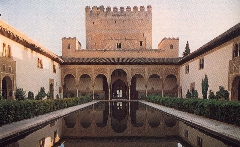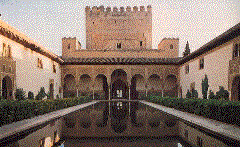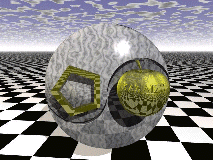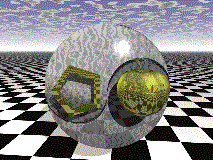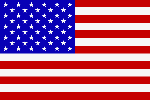Have you ever been surfing along and noticed that some images look pretty crappy? Like all full of speckles? If so, then you have fallen victim to the CLUT.
Now, before I go any further, let me warn you that I'm really not all that much of a computer geek, so I can only explain things as I understand them. That means I know what I'm talking about... most of the time. That said, let me try to tell you about the how's and why's of computer displays and colors... as I understand it.
* * *
Most computers can run in one of 3 (maybe more) color modes-
- 256 color
- high color (64,000 colors - I think)
- and true color (16.7 million colors)
If you are in true color mode your computer is configured to display up to 16.7 million distinct colors. That gives you a couple million shades of red alone. It's kind of nice because feathered edges look feathered, photographs look fantastic and nice backgrounds actually look nice!
There is a price to pay however. Your poor computer has to work extra hard trying to display everything. Consequently things tend to work a little slower and often a little jerkier. But I gotta admit, images look very good.
If you want to give your processor a bit of a break, you can set your computer to display 64,000 colors rather than 16.7 million. This is the high color mode. Although there is a huge difference between 16.7 million and 64,000 to your computer, the difference is hardly noticeable to your average run-of-the-mill human. You get nice looking images, nicely feathered edges and there's not much in the way of jerkiness or slowness in your display.
Now if your like me, and super high image quality takes a back seat to speed, and you want your display to take up as little resources as possible, or if you have an older computer, you putz around in 256 color mode. All this means is your computer says "Listen, I know that there are 16.7 million colors. But what I'm going to do is only use 256 at a time. If I have to display an image that technically has 80,000 colors in it, I'm just going to try and find the closest 256 colors and just use them. Deal with it."
Now let's take that one step further. Let's suppose your computer is in 256 color mode and you're running Netscape. Netscape says, "I am taking over your colors. Since you only have 256 colors to play with, I am assigning a permanent value to 216 of them. The remaining 40 can be used any way you want." The end result is Netscape dithers all images to those 216 colors.
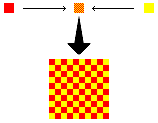 |
Dithering is when your computer takes a couple colors it has and tries to blend them to make a color that it doesn't have. This "dithering" is why images are sometimes speckled. |
Why does it do this?? Let's suppose you have a web page with two pictures on it. One picture contains 150 distinct colors. The second picture contains another 150 distinct colors. If you display them together then all of a sudden your computer has to deal with 300 separate colors, not to mention the colors for your taskbar and buttons, etc. This throws a serious monkeywrench into the 256 color idea. So what Netscape does is say "Here are the 216 colors we will use for ALL images. Everything gets dithered to these colors."
Netscape's 216 colors
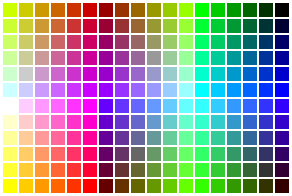
This group of colors is called a CLUT. As far as I know, all browsers have one. However, I don't know if all browsers use the same colors in their clut, or how colors and cluts and such work on operating systems other than Windows. (Hey, I warned you that I didn't know everything)
| Gradient 1 - 1125 colors |
Gradient 2 - 69 colors |
 |
 |
If both of the above images look about the same, then you are running a 256 color display and Netscape is dithering the image on the left to it's 216 colors. If the image on the left looks smooth but the image on the right looks all speckled, then you are running a high or true color display. The image on the left is a few simple gradients, saved in a low compression jpg format. In true color mode the gradient is very smooth and in high color mode it is still quite smooth (although the number of distinct colors falls to 313). The image on the right is a screen capture of the left image through 256 color mode.
I know its tempting to say phooey on anyone using only 256 colors, but keep in mind that alot of people do just that. If your image is a photograph in jpg format there's not too much you can do. Photographs are simply going to look a little worse to those running 256 colors.
| Button 1 - 18 colors |
Button 2 - 12 colors |
Button 3 - 5 colors |
 |
 |
 |
We have Image 1 and Image 2 just like the ones before. (the only exception is if you have Options/General Preferences/Images/Substitute Colors checked, in which case some drawn images will look nicer but other images may look worse. Go figure.). But now we have this third image. The third one should look just fine to everyone. It is nice and smooth even at 256 colors.
I did this by using a Netscape pallet in my graphics editor. You can do this too. If you load this image...

...into most any graphics editor you can make a color pallet from it. (Consult your graphic editor's instructions if you don't know how to do this). Then you're ready to go! You can import an existing picture and substitute the closest Netscape color for all the colors in the image. As you can see from the images above, the results are well worth the two minutes (at most) it takes to do this. If you are starting a new image, you can start with the Netscape colors. If your major areas are already done in Netscape's colors, and if you switch to 16.7 million colors for some further editing, when you go to substitute Netscape's colors back in, your image will look pretty much the way you intended. Plus it will look that way to everyone.
If you want to delve a little further into Netscape's browser clut, here's how they came up with the 216 colors. In our everyday life we use a base 10 number system. We use the following numbers...
0-1-2-3-4-5-6-7-8-9
Somewhere along the line, computer people decided that certain things would be easier to do if they used a base 16 number system...
0-1-2-3-4-5-6-7-8-9-A-B-C-D-E-F
Since we don't have a unique symbol for 10, 11, 12 etc, we use letters to represent those values. Below are both number systems counting to our 50...
| 0 |
1 |
2 |
3 |
4 |
5 |
6 |
7 |
8 |
9 |
10 |
11 |
12 |
13 |
14 |
15 |
16 |
17 |
18 |
19 |
20 |
21 |
22 |
23 |
24 |
25 |
26 |
27 |
28 |
29 |
30 |
31 |
32 |
33 |
34 |
35 |
36 |
37 |
38 |
39 |
40 |
41 |
42 |
43 |
44 |
45 |
46 |
47 |
48 |
49 |
50 |
| 0 |
1 |
2 |
3 |
4 |
5 |
6 |
7 |
8 |
9 |
A |
B |
C |
D |
E |
F |
10 |
11 |
12 |
13 |
14 |
15 |
16 |
17 |
18 |
19 |
1A |
1B |
1C |
1D |
1E |
1F |
20 |
21 |
22 |
23 |
24 |
25 |
26 |
27 |
28 |
29 |
2A |
2B |
2C |
2D |
2E |
2F |
30 |
31 |
32 |
So when someone talks about a "hex code" or "hexadecimal number" or if you see cryptic color codes like 09EC0A, CCFFCC, 00AACC, etc., this is what they're talking about and where it comes from. Taking it a little further, your computer understands colors in terms of red, green and blue values.
RED - GREEN - BLUE
or
R-G-B
Each of those can have a value from 0 to 255. 0 being the absence of color, 255 being full color. Using that scale, we get the following values...
| | RED= 255-0-0 |
| | GREEN= 0-255-0 |
| | BLUE= 0-0-255 |
| | BLACK= 0-0-0 |
| | WHITE= 255-255-255 |
Since we have 3 colors, each with a value that can range from 0 to 255 we have 16,777,216 possible color combinations (256 ³). So, that's how we get 16.7 million colors.
If we replace the decimal number with it's hexadecimal equivalent we start to get something that looks a little more like those "hex codes".
| | RED= FF-0-0 |
| | GREEN= 0-FF-0 |
| | BLUE= 0-0-FF |
| | BLACK= 0-0-0 |
| | WHITE= FF-FF-FF |
If we then use 00 for 0, and 01 for 1, etc., and if we get rid of the dashes(-), we then got ourselves some genuwine color codes!
| | RED= FF0000 |
| | GREEN= 00FF00 |
| | BLUE= 0000FF |
| | BLACK= 000000 |
| | WHITE= FFFFFF |
Now, how did Netscape go about choosing which colors to use? Rather than using 256 values for each of the three colors, they only use 6. Namely 0, 51, 102, 153, 204 and 255. If we translate those numbers into their hexadecimal equivalent we get 00, 33, 66, 99, CC and FF. Since that is six different values for each of 3 colors, there are 216 possible color combinations (6 ³).
If you go back to the color chart you saw before, you'll see a rendering of all these color combinations.
One last item. If a person is running a 256 color display and you have chosen a background color that is something other than one of Netscape's 216, then there is a very good chance that Netscape will instead pick the closest match from it's own colors. Sometimes this is not a good thing. I have seen pages where this left the text almost unreadable. Once again, I know it may be tempting to say 'too bad' to those of us in 256 color land. But...as I said before, there are alot of us. And if your goal is to design smart looking web pages, then you might want to consider spending the extra couple minutes to fine tune your graphics so you look good to everyone.
"And that's all I have to say about that." - Forrest Gump




